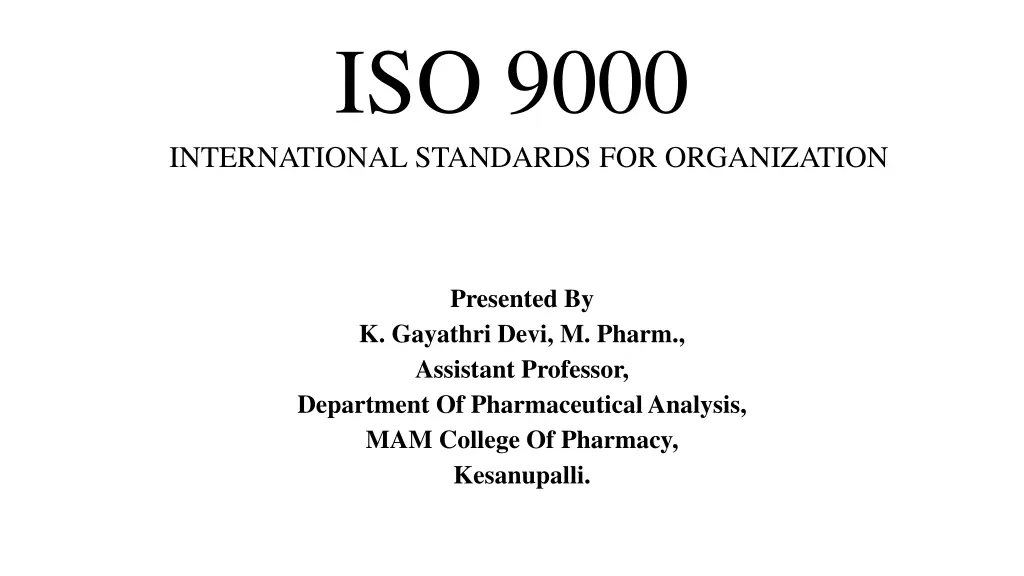
ISO 9000 International Standards for Quality Management Systems
"Discover the ISO 9000 standards designed to help organizations meet customer needs, statutory requirements, and achieve continual improvement in quality management. Learn about the advantages of ISO registration, the ISO 9000 series, and key clauses for quality management. Enhance market credibility, customer confidence, and competitiveness with ISO 9000. Find guidance on implementing quality principles and ensuring compliance with international standards."
Download Presentation

Please find below an Image/Link to download the presentation.
The content on the website is provided AS IS for your information and personal use only. It may not be sold, licensed, or shared on other websites without obtaining consent from the author. If you encounter any issues during the download, it is possible that the publisher has removed the file from their server.
You are allowed to download the files provided on this website for personal or commercial use, subject to the condition that they are used lawfully. All files are the property of their respective owners.
The content on the website is provided AS IS for your information and personal use only. It may not be sold, licensed, or shared on other websites without obtaining consent from the author.
E N D
Presentation Transcript
ISO 9000 INTERNATIONAL STANDARDS FOR ORGANIZATION Presented By K. Gayathri Devi, M. Pharm., Assistant Professor, Department Of Pharmaceutical Analysis, MAM College Of Pharmacy, Kesanupalli.
Introduction to ISO 9000 The ISO 9000 family of standards is related to quality management systems and designed to help organizations ensure that they meet the needs of customers and other stakeholders while meeting statutory and regulatory requirements. ISO 9000 deals with the fundamentals of quality management systems, including the eight management principles on which the family of standards is based. International standards promote international trade by providing one consistent set of requirements recognized around the world. ISO 9000 can help a company satisfy its customers, meet regulatory requirements and achieve continual improvement. It provides the base level of a quality system, not a complete guarantee of quality. Originally published in 1987 by the International Organization for Standardization (ISO), a specialized international agency for standardization composed of the national standards bodies of 90 countries..
ISO 9000 Series ISO 9000: Explains fundamental quality concepts and provides guidelines for the selection and application of each standard ISO 9001: Model for quality assurance in design, development, production, installation and servicing. ISO 9002: Model for quality assurance in the production and installation of manufacturing systems. ISO 9003: Quality assurance in final inspection and testing. ISO 9004: Guidelines for the applications of standards in quality management and quality systems. ISO 9000 and ISO 9004 are guidance standards. They describe what is necessary to accomplish the requirements outlined in standards 9001, 9002 or 9003.
Advantages Quality is maintained ISO registration also has a significant bearing on market credibility as well. Opportunity to compete with larger companies More time spent on customer focus Confirmation that your company is committed to quality May facilitate trade and increased market opportunities Can increase customer confidence and satisfaction.
Quality Management Clause General requirements Documentation requirement Quality manual Control of records and documents Management responsibility clause Customer focus Quality objective Quality policy Quality management system planning Management representative Internal communication
Resource management requirement clause Competence, awareness and training Infrastructure Work environment Product realization requirement clause Planning of product realization Customer related process Customer communication Measurement, analysis and improvement clause General requirements Monitoring and measurement customer satisfaction Internal audit Analysis of data Continual improvement
